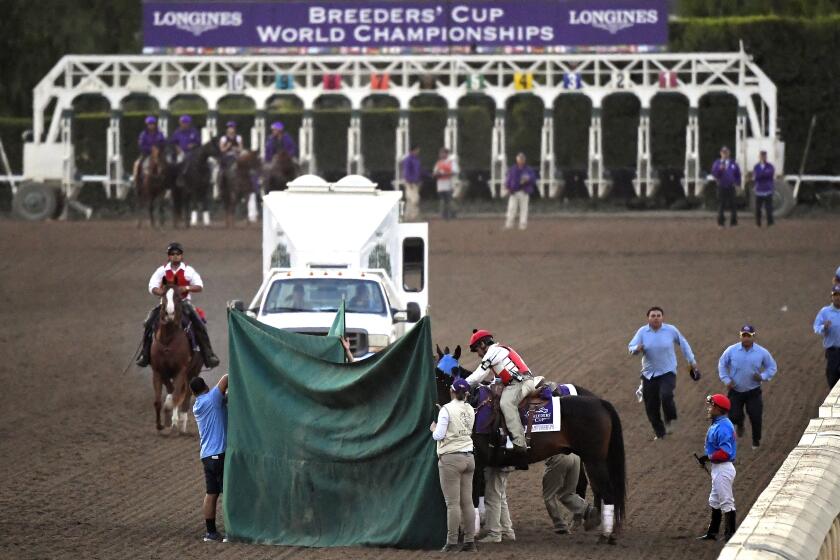Santa Anita looks to future after closing a frightful year

- Share via
For two days, the best horses in the world traveled a collective distance of about 14 miles over the dirt and turf courses at Santa Anita. The Breeders’ Cup was within the final furlong of having a great and safe racing weekend.
And then it happened.
At the top of the stretch in Saturday’s last race, the $6-million Breeders’ Cup Classic, Mongolian Groom broke down with a hind leg injury and was euthanized. Gone were the memories of 13 competitive races and instead the focus was on the one thing that went terribly wrong.
“It was about a glorious two days of racing and then that thing happened and everyone is broken-hearted about it,” said Aidan Butler, acting executive director of California racing for The Stronach Group, of Mongolian Groom’s injury.
Butler was moved from his job as chief strategy officer and put in charge of Santa Anita after a disastrous winter/spring meeting during which 30 horses died. TSG’s chairman, Belinda Stronach, instituted a series of medication and veterinary reforms that were aimed at curtailing horse fatalities.
Expectations were high for a safe fall meeting, especially after Del Mar had no racing fatalities during its seven-week summer meeting. But even before opening day in Santa Anita’s six-week meeting, a horse died while training. And they kept coming. When the meet closed Sunday, there were four horses dead from racing and three from training. Last year, there were only four in the same period of time.
“You can’t slice in time anything from a data standpoint,” Butler said. “The test of this is going to happen over time. I can’t let this discourage the hard work, knowing what’s been going on, the amount of effort making sure the horses and riders are as safe as they could possibly be. But, of course, there is always improvement to be made across the board. We are looking at everything.”
How Santa Anita compares to other tracks is not a seamless process. The Jockey Club has the Equine Injury Database, a self-reporting system that only counts racing deaths, not those that happen when training. Given the disparity in racing dates, number of races and horses that are entered, the metric used is deaths per 1,000 starts. Last year, the industry average was 1.68. This year, Santa Anita’s is nearly double that at 3.34. Santa Anita had 23 racing fatalities this year, two fewer than it had in 2016 when its rating was 2.83. That year, the track had almost 2,000 more starts.
Until Saturday’s climactic race of the two-day Breeders’ Cup at Santa Anita, NBC had been quite thorough in providing proper context and measured tones in documenting what had occurred at the track in light of 36 thoroughbred deaths since December.
Last year, Santa Anita’s rating was 2.04 with 18 racing deaths. Hawthorne Race Course in Chicago had a rating of 2.99 and Churchill Downs had 2.7. Del Mar’s rating was 0.79.
“In my heart I know we’re doing the right things,” Butler said. “I see the amount of checks. To innovate out of a thing like this, it’s going to take time. I know we are going to make things better. … Nothing is going to make me waver from getting this done.”
Butler, and the whole Stronach Group racing division, will get a new boss later this week. Craig Fravel, who is chief executive officer of the Breeders’ Cup, is moving to TSG as its new chief executive. The Breeders’ Cup would not make Fravel available to the Los Angeles Times on Sunday.
One of the decisions he’ll have to make is whether to install a synthetic track at Santa Anita, one of the few major steps the track could do to rebrand itself. Statistically, a synthetic track is safer than dirt, although it may result in more soft-tissue injuries. Currently, there are synthetic tracks at Golden Gate Fields, owned by TSG, Arlington Park near Chicago and Woodbine Racetrack in Canada.
Butler was vague about the possibility of switching to synthetics and said everything is on the table. When asked if a new surface could be in place by the next meeting, he was clear.
“Not with any level of confidence that we’ve done the right thing,” Butler said. “It’s not like even the big companies have the materials on a shelf. What’s the expression? Measure twice and cut once. Take your time to do it right and then do it right.”
During the last race on Sunday, a $12,500 claiming race, Iron Curtain was pulled up near the eighth pole. The horse ambulance was brought out as track employees and fans were afraid they were reliving the horror of the Breeders’ Cup Classic on Saturday. The veterinarians inspected the horse on the track and he walked easily into the van. He was then taken to the barn rather than the equine hospital, usually a good sign.
It turns out he just lost a shoe.
Santa Anita exhaled and now it’s Del Mar’s turn to hold its breath. Racing returns to the seaside track Friday. Santa Anita opens its next winter/spring season Dec. 26.
More to Read
Go beyond the scoreboard
Get the latest on L.A.'s teams in the daily Sports Report newsletter.
You may occasionally receive promotional content from the Los Angeles Times.












